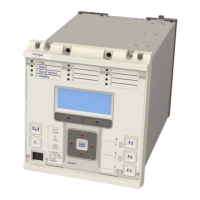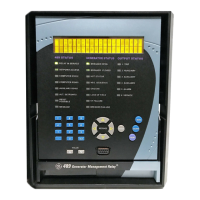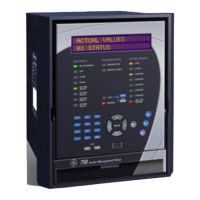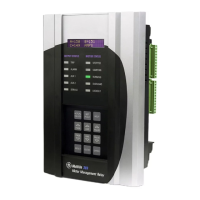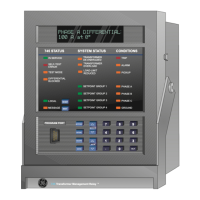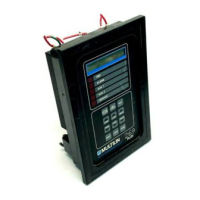Appendix B -Settings and Signals
MENU TEXT COL ROW DEFAULT SETTING AVAILABLE OPTIONS
DESCRIPTION
Setting that defines the operative mode of the received InterMiCOM_6 signal.
When ‘Direct’ tripping is chosen, for security reasons 2 consecutive valid messages have to be received before a change in the signal status
will be acknowledged. That will impose an additional 1-2 ms delay comparing to ‘Permissive’ mode.
Set ‘Direct’ in Direct Transfer Tripping (Intertripping) applications.
Set ‘Permissive’ to accommodate any Permissive or Blocking scheme.
IM6 FallBackMode 20 45 Default
Latched
Setting that defines the status of IM6 signal in case of heavy noise and message synchronization being lost.
If set to Latching the last valid IM6 status will be maintained until the new valid message is received.
If set to Default, the IM6 status, pre-defined by the user in IM6 Default Value cell will be set. A new valid message will replace IM6 Default
Value, once the channel recovers.
IM6 DefaultValue 20 46 0
0 or 1
[Unsigned Integer(16 bit)]
Setting that defines the IM6 fallback status.
IM7 Cmd Type 20 48 Permissive
Permissive
Setting that defines the operative mode of the received InterMiCOM_7 signal.
When ‘Direct’ tripping is chosen, for security reasons 2 consecutive valid messages have to be received before a change in the signal status
will be acknowledged. That will impose an additional 1-2 ms delay comparing to ‘Permissive’ mode.
Set ‘Direct’ in Direct Transfer Tripping (Intertripping) applications.
Set ‘Permissive’ to accommodate any Permissive or Blocking scheme.
IM7 FallBackMode 20 49 Default
Latched
Setting that defines the status of IM7 signal in case of heavy noise and message synchronization being lost.
If set to Latching the last valid IM7 status will be maintained until the new valid message is received.
If set to Default, the IM7 status, pre-defined by the user in IM7 Default Value cell will be set. A new valid message will replace IM7 Default
Value, once the channel recovers.
IM7 DefaultValue 20 4A 0
0 or 1
[Unsigned Integer(16 bit)]
Setting that defines the IM7 fallback status.
IM8 Cmd Type 20 4C Permissive
Permissive
Setting that defines the operative mode of the received InterMiCOM_8 signal.
When ‘Direct’ tripping is chosen, for security reasons 2 consecutive valid messages have to be received before a change in the signal status
will be acknowledged. That will impose an additional 1-2 ms delay comparing to ‘Permissive’ mode.
Set ‘Direct’ in Direct Transfer Tripping (Intertripping) applications.
Set ‘Permissive’ to accommodate any Permissive or Blocking scheme.
IM8 FallBackMode 20 4D Default
Latched
Setting that defines the status of IM8 signal in case of heavy noise and message synchronization being lost.
If set to Latching the last valid IM8 status will be maintained until the new valid message is received.
If set to Default, the IM8 status, pre-defined by the user in IM8 Default Value cell will be set. A new valid message will replace IM8 Default
Value, once the channel recovers.
IM8 DefaultValue 20 4E 0
0 or 1
[Unsigned Integer(16 bit)]
Setting that defines the IM8 fallback status.
User Banner 25 01
ACCESS ONLY FOR
AUTHORISED USERS
From 32 to 234 in steps of 1
[ASCII Text]
Attempts Limit 25 02 2
From 0 to 2 in steps of 1
[Unsigned Integer (16 bits)]
Attempts Timer 25 03 2
From 1 to 3 in steps of 1
[Unsigned Integer (16 bits)]
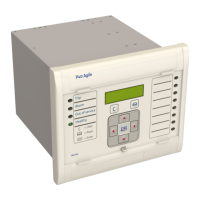
